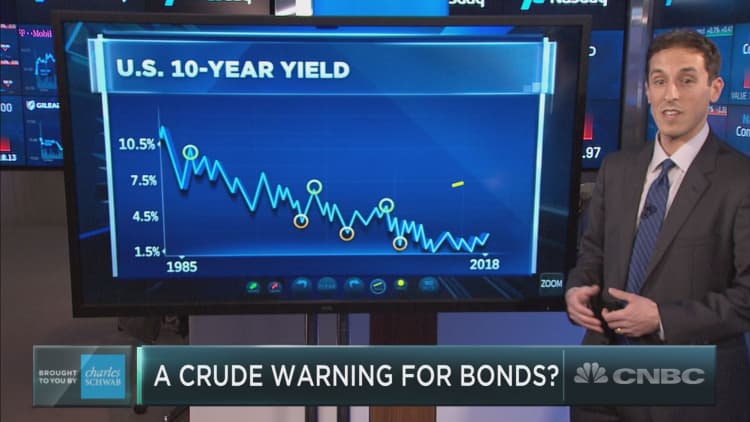
The Federal Reserve is sure to hike interest rates again this year, but the key question is how many times. One market watcher says investors could look in an unusual place for a clue.
Crude oil prices are a leading indicator in evaluating whether inflation is getting too hot and the Fed is ready to play catch-up, according to Charlie Bilello, director of research at Pension Partners.
"We have this interesting phenomenon where crude oil is highly correlated to the direction of inflation expectations," Bilello told CNBC's "Trading Nation" on Thursday.
Crude can be seen as a predictive measure for overall inflation as its moves impact energy prices in real time. Crude oil prices have moved in lockstep with inflation expectations, as measured by the iShares TIPS bond ETF relative to the iShares 7-10 year Treasury bond fund, Bilello said.
From 2014 to 2016, for example, when the oil glut pushed crude below $30 a barrel, inflation expectations also tumbled.
"During that period you have extremely easy central bank policies," said Bilello. "The fears were deflation, you had the ECB go negative on interest rates, the Bank of Japan go negative on interest rates and you had the Fed very reluctant to hike rates."
Since 2016, crude oil has made a roughly 160 percent advance, picking up speed this year, and inflation expectations have risen alongside it. President Donald Trump tweeted a blast against OPEC on Friday, accusing the oil bloc of keeping prices "artificially very high."
The rising prices should push the Fed to move rates higher to avoid being behind the curve.
"The Fed is hiking more aggressively, expected to hike three or four times this year, and now we're talking about other central banks joining as well," said Bilello. "The environment is changing, and I think this is an important relationship to watch going forward."
While common thinking is that easy money on the equity market will cease once the Fed pushes rates higher, Bilello says history shows the opposite to be true.
"If we look back in history, there's been some inflection points back in 1987, back in 2000 and back in 2007, you had yields failing to break higher," he said. "It ended up being a bad thing for the equity market."
By comparison, in 1988, 2003 and 2008 when yields failed to break lower and rates pushed higher, the equity market took off, he said.
"If you're worried about higher interest rates and you're hoping that they go back down, be careful what you wish for because it may mean an economy slipping into a recession or some turmoil in the markets," he added.
The yield on the 10-year Treasury rose to 2.93 percent on Thursday, its highest level since March 21. Yields have not topped 3 percent since January 2014. West Texas Intermediate crude ended Thursday's session at $68.29 a barrel.






